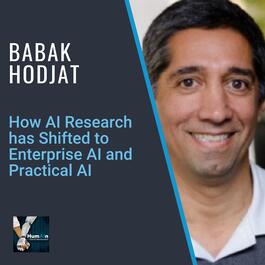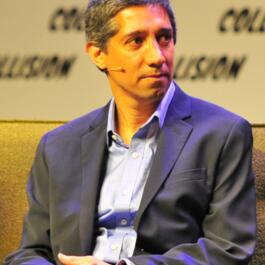
How AI Research has shifted to Enterprise AI and Practical AI with Babak Hodjat, VP of Evolutionary AI at Cognizant
[Audio] Podcast: Play in new window | Download Subscribe: Google Podcasts | Spotify | Stitcher | TuneIn | RSS Babak Hodjat is Vice President of Evolutionary AI at Cognizant, and former co-founder and CEO of Sentient. He is responsible for the core technology behind the world’s largest distributed artificial intelligence system. Babak was also the founder of the world's first AI-driven hedge fund, Sentient Investment Management. He is a serial entrepreneur, having started a number of Silicon Valley companies as main inventor and technologist. Prior to co-founding Sentient, Babak was senior director of engineering at Sybase iAnywhere, where he led mobile solutions engineering. He was also co-founder, CTO and board member of Dejima Inc. Babak is the primary inventor of Dejima’s patented, agent-oriented technology applied to intelligent interfaces for mobile and enterprise computing – the technology behind Apple’s Siri. He is an expert in numerous fields of AI, including natural language processing, machine learning, genetic algorithms and distributed AI and has founded multiple companies in these areas. Babak holds a Ph.D. in machine intelligence from Kyushu University, in Fukuoka, Japan. Episode Links: Babak Hodjat's LinkedIn: https://www.linkedin.com/in/babakhodjat/ Babak Hodjat's Twitter: @babakatwork Babak Hodjat’s Website: https://digitally.cognizant.com/author/babak-hodjat Podcast Details: Podcast website: https://www.humainpodcast.com Apple Podcasts: https://podcasts.apple.com/us/podcast/humain-podcast-artificial-intelligence-data-science/id1452117009 Spotify: https://open.spotify.com/show/6tXysq5TzHXvttWtJhmRpS RSS: https://feeds.redcircle.com/99113f24-2bd1-4332-8cd0-32e0556c8bc9 YouTube Full Episodes: https://www.youtube.com/channel/UCxvclFvpPvFM9_RxcNg1rag YouTube Clips: https://www.youtube.com/channel/UCxvclFvpPvFM9_RxcNg1rag/videos Support and Social Media: – Check out the sponsors above, it’s the best way to support this podcast – Support on Patreon: https://www.patreon.com/humain/creators – Twitter: https://twitter.com/dyakobovitch – Instagram: https://www.instagram.com/humainpodcast/ – LinkedIn: https://www.linkedin.com/in/davidyakobovitch/ – Facebook: https://www.facebook.com/HumainPodcast/ – HumAIn Website Articles: https://www.humainpodcast.com/blog/ Outline: Here’s the timestamps for the episode: (00:00) – Introduction (01:34) – Machine learning and AI based algorithms are being used to get a sense of what is happening in an organization, abstracting out patterns, and then to be able to actually forecast and make predictions into the future. We need to have our AI systems help us with the decision-making itself. (03:59) – Humans are really good at general intelligence. We know a lot of things about a lot of things. So often that state-of-the-art in AI can not capture things like common sense. The frequency of making decisions is slow enough that we can have a human in the loop.Today, it does still make sense to have a human in the loop. There are cases where we have to rely on our AI systems to make autonomous decisions for us. (06:54) – We can build models that are specialized in assessing certainty in our AI systems and the way they do that is based on familiarity on the input side, the context side and familiarity on the output side. (09:57) – Our systems have to be able to tell us how much we can rely on them. You need confidence in what the AI system is telling you to do, but then there is risk sort of projecting that confidence out. Past performance is no indication of future returns. (11:36) – Companies and enterprises have definitely reprioritized things. They have maintained, or even in some cases increased their investments in AI enablement, which says a lot about the value that people ascribe to AI based systems. It is a natural next step to digitizing your business. (14:45) –Evolutionary AI is a set of tools that we use to build AI systems and AI enabled companies. The reason why it's called evolutionary AI beyond the fact that it's an evolution in the way people should think about AI, is that a very strong core component of it is evolutionary computation. We do pull from other AI disciplines as well, such as deep learning and neural networks and so forth, but the essence, the main differentiation here is the fact that we have an element of what I call creativity that is missing in a lot of AI systems. 15:29) – We're able to search for solutions much more efficiently than we are with your typical machine learning based systems. And that speed and efficiency allows us to be much more creative and find solutions that are either very difficult to arrive at using other methods or impossible to arrive at. So it also gives us a number of very interesting capabilities. (20:09) – What evolutionary AI allows us to do is to actually use machine learning to create what we call a surrogate for the real world. That surrogate is learned off of data that we've seen up until now. (20:47) – This is the principle of what we call evolutionary surrogate assisted prescriptions, where you have a predictor, which is the surrogate for the real world. You have a prescriptive that you evolve, which gives you a decision strategy. And often you pair that with a certainty model. So when the three of these come together, you have all the elements of a good decision augmentation system, where a human decision maker, let's say a policy maker would ask the AI, how can I achieve this balance of cost and containment. (24:46) – Optimization is where we need to be. And that is what decision-making is about. We are constantly optimizing and trying to improve on goals and outcomes. (29:25) – There's a lot of work around new architecture, search and evolving, basically the design and hyper parameters of any kind of deep learning based system. (36:57) – More and more companies are going to adopt this technology for decision-making and it will start with areas where the decision-making has been captured. So the data around the decision-making is already there, but it will not stay there. It will get to areas where we think decision-making is the soul. (38:20) – If you are in an organization or enterprise where there's critical decision-making happening, work back from there. You have to have a vision of AI enablement in order to even get the data and digital part of what you do. Build your Data infrastructure, modernize it, report on top of that, build your machine learning and forecasting and predictions on top of that. Advertising Inquiries: https://redcircle.com/brands Privacy & Opt-Out: https://redcircle.com/privacy
From "HumAIn Podcast"




Comments
Add comment Feedback